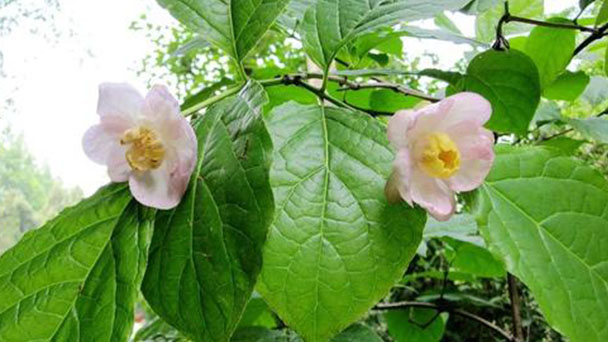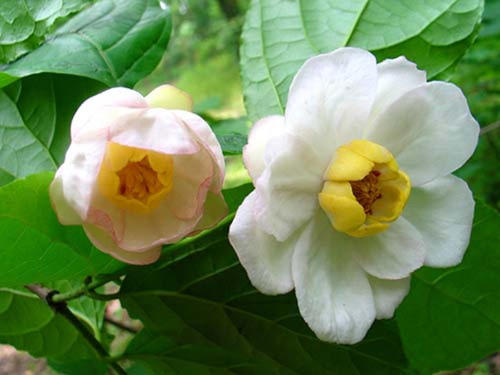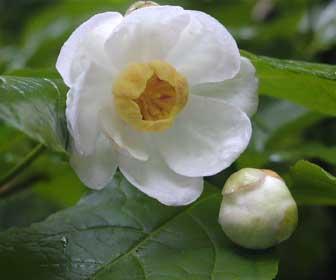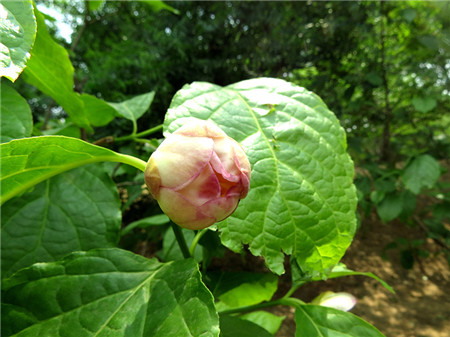Calycanthus chinensis (Chinese sweetshrub) profile
Written by Maggie
Mar 02 2021

Chinese Sweetshrub is a genus of plants in the family Dwamaceae, scientific name: Calycanthus chinensis Cheng et S. Y. Chang, a deciduous shrub, 1-3 m tall. Leaves are opposite, membranous, wide ovate elliptic, round ovate to obovate. Chinese Sweetshrub likes shade, like warm and humid climate and well drained moist sandy loam soil. Chinese Sweetshrub was born at an altitude of 600-1000 meters mountain ditch under the shade. It is a second-class plant under national protection.
Chinese sweetshrub picture

Morphological characteristics of Chinese sweetshrub
Chinese Sweetshrub is 1 to 3 m tall; Bark is grayish white or grayish brown, lenticels raised; Branchlets are opposite, glabrous or sparsely puberulent when young; The buds are hidden in the base of the petiole. Leaves of chinese sweetshrub are wide ovate-elliptic, ovoid or obovate, 11-26 cm long, 8-16 cm wide, slightly asymmetrical on both sides of the base, entire or irregular serrata, glossy, slightly rough, glabrous, brown bristles along veins on the back of the leaves when young, glabrous gradually;Petiole 1.2-1.8 cm long, covered with yellow bristles, later glabrous. The foliage is deciduous and texture, Chartreuse/Yellow color.
Flowers of Chinese Sweetshrub are fragrance-free, 4.5 -- 7 cm in diameter; The bloom color is white or near white. Pedicels are 2 -- 2.5 cm long, sometimes up to 4.5 cm, bearing 5 -- 7 bracts, bracts caducous, backward scarred; Tepals are spiral in goblet or places of the receptacle, outer tepals 12-14, obovoid or spoon oval, 1.4 3.6 cm long, 1.2 2.6 cm wide, white, violet red edge, veins, inside the tepals 9-12, upright, the inside of the top, elliptic, 1.1 1.7 cm long, 9-13 mm wide, above the central light yellow, under the middle white, inside base have lavender red stripes; Stamens of Chinese Sweetshrub are 18-19, ca. 8 mm, anthers densely pubescent, connectors mucronate; Chinese Sweetshrub has 11-12 stamens, puberulent; Chinese Sweetshrub has 11-12 carpel, inserted into cup-shaped or altar-shaped receptacle, sericeous, style filiform elongation.
Fruit rectum of Chinese Sweetshrub is campanulate or constricted near terminal, 3 -- 4.5 cm long, 1.5 -- 3 cm in diameter, densely pilose, apically with 14 -- 16 lanceolate subulate appendages; Achene is oblong, 1-1.6 cm long, 5-8 mm in diameter, sericeous.
Ecological habits of Chinese Sweetshrub
Chinese Sweetshrub was produced in China, Zhejiang Changhua and Tiantai and other places. Chinese Sweetshrub was born at an altitude of 600-1000 meters mountain ditch under the shade. Chinese Sweetshrub is suitable for a damp, humus soil, happy event is warm, humid environment, afraid of strong sunlight, grow well under the soft sunlight, should be planted in thin forests or other summer without direct sunlight place, if the light too strong, coated dry-hot wind can make the petals wither, should be timely to the plant and the surrounding water, increase the humidity of the air, can prolong flowering. In loose fertile, good drainage soil growth, growth period to keep the soil moist, rainy continuous to pay attention to drainage, so as not to soil water lead to root rot.
The distribution of Chinese Sweetshrub
Chinese Sweetshrub is a deciduous shrub belonging to the Cereaceae family. It is a tertiary relict species and the only representative of Chinese Sweetshrub and has a unique taxonomic position in the Cereaceae family. Chinese Sweetshrub has large flowers, peculiar flower shapes and high ornamental value. Its natural distribution is limited to very narrow areas such as Lin 'an and Tiantai in Zhejiang Province.
The way Chinese sweetshrubs propagate
Propagation methods of Chinese Sweetshrub mainly include seeding, division and layering.
Seeding method
In autumn, when the outer shell of Chinese Sweetshrub achenes turns from green to yellow and the inner seeds turn brown and black, the achenes can be harvested. The seeds are taken out and stored after drying in the shade. During the storage of the seeds, attention should be paid to maintaining the humidity. Autumn sowing or spring sowing, before sowing, seeds soaked with warm water, sprout 24 hours, can ensure a higher rate of germination. In addition, the selection of well-drained moist soil as a seedbed, seedling survival rate is higher. Seedling period should be shaded, winter to cover antifreeze. The seedlings of Chinese Sweetshrub are suitable for growing in a dry environment without strong light exposure.
Division
Because of its strong tillering ability, Chinese Sweetshrub roots should be dug up after falling leaves in autumn and before germination in spring, and then divided into several small plants with a sharp knife or hacksaw. Each plant should have 1-2 taproot roots, and then planted. Easy to survive, 2-3 years will be able to flower.
Layering
There are ordinary layering, trench layering, pile layering, basin layering and high-altitude layering. In spring, the 1-2 year old twigs should be selected and cut into the soil with a knife according to different methods. Then sprinkle a little ATP root powder or apply 500ppm naphthyl acetic acid on the cut parts, and then bury them in the soil with husker and ash as the medium. The soil should be kept wet frequently.

How to grow and care for Chinese sweetshrub
The temperature
The growth temperature of Chinese Sweetshrub is between 20℃ and 28℃, and it can withstand the extreme low temperature of -14℃ and the extreme high temperature of 35℃ in its origin. From the introduction of cultivation in Anhui Province, Huangshan 440m above sea level, Hefei 50m above sea level, Chuxian 120m above sea level, Jingxian 250m above sea level, planted in the general garden, winter -10℃ low temperature can be safe, summer 38℃ extreme maximum temperature, did not appear leaf burn crimping, and can be normal flowering seed reproduction. In the landscape planting, summer in the high temperature period, it is best to give foliar water spraying; Potted Chinese Sweetshrubs should be maintained at a low temperature of not less than -5℃ in winter, otherwise even if the plants are not frozen to death, the pot will also be frozen crack, can be put in a simple plastic greenhouse, keep the pot soil freeze-free can be frozen.
Light
Chinese Sweetshrub is not very strict with light. It can be planted in a location away from the west sun, or in the sparse shade of a deciduous tree, or in a slightly higher place near the pond. Potted Chinese Sweetshrub has strict requirements on illumination. In spring and autumn, it can accept full illumination. However, in summer, Chinese Sweetshrub should be appropriately shelved and shaded to create a semi-shady environment for it, so as to promote its vigorous growth, dark green leaves and large flowers. Under the strong light without blocking, the growth is poor, the leaves are yellow, and even the tip of the leaf is dry and the leaf margin is curled; In particular, attention should be paid to prevent the spring and summer at the turn of the long rain when the sun, in order to prevent the young leaves of the new shoot was burned.
Moisture
Land planting location, the requirement of moist soil, moist environment. Potted Chinese Sweetshrub in the growing season, not only requires to keep the basin soil moist, but also in 3-5 days without rain, to give foliar water, increase air humidity; Especially in midsummer, the temperature is high, the light is strong, can be shaded by the arch shed, to the environment and leaf water and other measures, to achieve the purpose of temperature and temperature, to maintain the growth potential to create a favorable conditions. It is not tolerant of waterlogging, all the year round to ensure that the basin soil does not appear water, otherwise it is easy to cause plant rot root leaves, affect the flowering and normal growth of the year.
Soil
Planting in the garden or courtyard requires deep and fertile soil, good permeability, rich in organic matter, no water, acid reaction, pH between 4.6-6.5. Potted soil, usable leaf soil or peat soil 5, garden soil 3, sand 1, mature organic fertilizer 1, mix evenly after sifting standby. Replace potted Chinese Sweetshrub every half a month during the growing season; Plum rain season, to be careful against basin soil water; Before sprout in the spring, turn the pot and replace the soil.
Fertilizer
Plant a year can be applied 3 times fertilizer, the first time in the spring just began to sprout, the second time after the flower wither, the third time in the late autumn and early winter leaves, each plant can be buried with 0.5Kg of decayed cake fertilizer or chicken manure. Potted Chinese Sweetshrub, growing season, every half a month to pour a thin cake fertilizer water, see the bud after continuous topdressing 2-3 times 0.5% calcium superphosphate solution, or 2% potassium dihydrogen phosphate plus 0.1% urea mixture; After the flower wither picks the residual flower to be defeated in time stem, apply again 1-2 time cake fertilizer water, add the potassium of 0.2% phosphoric acid dihydrogen, in order to benefit the plant vigorous growth next year bloom again.
Disease control of Chinese sweetshrub
Anthrax spot
Mainly at the seedling stage of harm, resulting in leaf spots, yellow leaves, emaciated Chinese Sweetshrub.
Prevention and control methods: at the end of autumn and early winter, the fallen leaves of Chinese Sweetshrub are burned, which can reduce the occurrence of disease in the coming year; If a small amount of diseased leaves are found, pick them and destroy them in time. At the beginning of the disease, 50% of anthrax magnesium wettable powder 500 times liquid was sprayed on the infected plant, once every 10~15 days, for 3~4 consecutive times.
The moth
Mainly to larva gnawing leaves, resulting in seedlings 100 holes thousand holes, very ugly. Prevention and control method: can use 2.5% kungfu emulsion 1000 times liquid in early, late spray branches and leaves, can effectively kill its larvae.
The function of Chinese sweetshrub
Watch
Chinese Sweetshrub is a kind of flower shrub worthy of being used in garden and green space. It can be planted alone, in clusters or in pairs. Chinese Sweetshrub is suitable to be planted in the place of half shade and half sun and under the forest with scattered light and the place of building backlight.Such as the courtyard, rockery, trees, the edge of the forest. Chinese Sweetshrub also can be potted ornamental, decorate the balcony, courtyard and so on.Its shadow is oblique and colorful. The oval yellow-green leaves set off the white flowers, which curl inwards and wrap tightly around the middle golden stamen, showing a very elegant beauty.
Medical value
Chinese Sweetshrub medicine, the flower bud in the first flower, has the effect of relieving heat, heat, regulating qi, cough and so on. Flowers and roots can cure stomach ache.
Chinese Sweetshrub leaves contain volatile aromatic oil, which has long been used in Chinese folk medicine. The pharmacopoeia records the leaf and its production of the tea, which is used for the prevention and treatment of cold and influenza. Modern pharmacological experiments also proved that in addition to the prevention and cure of cold, wintersweet tea also has a certain antitussive effect and mild antiasthmatic effect.

Latest Updated
- Benefits of Bugleweed - 7 Science-backed Health Benefits
- Bugleweed Dangers & Side Effects - Is It Poisonous?
- How to Plant Evergreen Trees - What You Should Know
- When to Plant Evergreens - Grow Guide for Evergreen Trees
- 12 Wonderful Evergreen Shrubs for Your Garden
- 12 Popular Evergreen Plants with Pictures for Beginners
- When And How To Prune A Lilac Bush Like a Pro
- How to Grow & Care for Lilac Vine (Hardenbergia Violacea)
- Japanese Lilac Tree (Syringa Reticulata) Care & Propagation Guide
- Shumard Oak Pros and Cons - What to Know
Popular Articles
- Winter maintenance of Antirrhinum Majus
- How to Grow Terminalia Mantaly Tree
- How to Grow and Care for Crossostephium Chinense
- How to grow Antirrhinum Majus in spring
- Peristeria Elata (Dove Orchid) Profile: Info & Care Guide
- Underwatered Snake Plant (Sansevieria Trifasciata) - Signs And How To Fix
- How to Care for Brazilian Jasmine Plant (Mandevilla Sanderi)
- How to Grow & Care for Graptopetalum Purple Delight in Summer
- Rosa Chinensis (China Rose): Plant Growing & Care Tips
- How to Care for Baby Sun Rose (Aptenia Cordifolia)